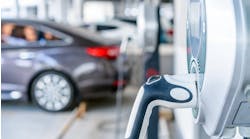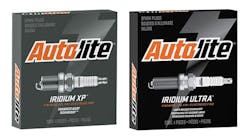Trendsetter, leader, trailblazer—there are many adjectives one could use to describe Sunil Patel.
But he likes to use another word.
“I’d like to be a disruptor in this industry,” he says.
Let’s step back for one second and take a look at his two-shop operation, Motorwërks Autogroup: As a former physician, Patel has modeled his processes and procedures after hospitals. His technicians do “morning rounds” on the day’s vehicles each morning; he’s invested in oscilloscopes and scan tools, housed medical carts that move between cars; the facilities are heavy on IP infrastructure, featuring 42-unit racks equipped with servers and security systems.
In short, Patel loves pushing his own operation to its limits.
But here comes the “disruption” part.
“We use our medical expertise to run our shops, and we think what we do can help other shop owners,” he says.
“Disrupt” may have a negative connotation, but Patel views his story as more of a necessary interruption, a wake-up call for a trade so steeped in tradition that it’s difficult for automotive repair to collectively move forward as an industry. And he believes the new management system he’s developing—which is modeled after his own $4 million operation—can spark that change.
People like Patel are well aware they’ll receive a lot of pushback from said industry, but that’s the bittersweet life of an innovator, Bob Dupre says.
“That's the price you pay for trying to establish yourself as an expert in the field,” says Dupre, president of CARS of America.
As someone who’s invested heavily in electric vehicle training and equipment for his small MSO, Dupre also understands what it feels like to stand apart from the competition. But his standout operation is living proof that with risk comes reward.
Being an innovator isn’t a curse, but a blessing, and both Dupre and Patel’s successful operations are here to serve as inspiration—to cause a disruption. These are their principles for becoming an innovator.
A Voice in the Wilderness
Bob Dupre has been in this business for a while, and has pretty much seen it all, from the early onset of catalytic converters to the emergence of electronic fuel injection to the introduction of four-wheel drive.
But this? This is different.
“It’s the 1980s on steroids,” he says.
The 1980s weren’t just a revolutionary time for automotive manufacturers, but for the repairers of those vehicles, as well. While some were intrigued by the changes and willing to take on new equipment and training, Dupre says many shop owners saw the massive readjustment as a time to ease out of automotive repair—others chose to ignore the changes, and “now they’re out of business.”
Dupre, however, chose to invest and adapt, keeping in step with vehicular modulations, earning his two-shop Chicago-area business a reputation as an up-to-date, progressive operation.
Now, with the influx of electric vehicles (EVs), he’s starting all over again by focusing his employees’ training and shop’s branding on EV repairs and battery refurbishments. The shop’s battery refurbishing bay, in-house training center, processes and marketing is all coupled with a heavy EV focus, which allows CARS of America to stand out from his competition and get a headstart on securing work from a growing EV population.
In order for his $2 million operation to truly disrupt the market, he had to follow a few key principles:
Principle #1: Separate yourself from the competition.
In 2015, CARS of America lost a fleet account that took 25 percent of its business. It was a stressful time for Dupre, who had to quickly survey his options and find an alternative.
And, on paper? EVs sounded pretty promising.
“Our market is the affluent North Shore,” Dupre says. “People tend to buy new technology, and can afford to do that.”
Not every shop owner is blessed with a wealthy demographic that invests in luxury vehicles and EVs, but that’s not the point here, Dupre says. The real point is that he studied his market, spotted an opportunity, and then took advantage.
Dupre made an EV investment because he knew very few shops in his region (or in the industry, period) would take that chance. During the 1980s, Dupre saw auto repair shop after auto repair shop shutter its doors as vehicles became more complicated—and those were the days when “leverage learning” made everything easier.
Leverage learning meant principles understood about one make or model could be applied to any other vehicle. If you understood how an alternator worked on a Chevy? You could perform electrical testing on “any kind of car out there.”
“On these cars,” Dupre says in reference to EVs, “you’re starting over again. It’s not like going from a carburetor to fuel injection. We’re going from a gasoline-driven vehicle that runs on 12 volts DC to a non-gas engine vehicle that runs on an electric motor at about 400 volts AC.”
Basically: Unless you’re a commercial electrician, each vehicle presents new challenges and requires unique procedures. Dupre recognized other shop owners were likely unwilling to create new processes and procedures for each EV that came through the shop.
“It’s a whole new experience,” he says. “And I think that’s going to have bigger impact on workforce and shop availability than changes back in ’80s. We have a self-induced labor shortage, which is going to compound that problem.”
Principle #2: Create your own market.
Separated from the day-to-day hustle and bustle of daily maintenance and repairs is a small section of Dupre’s shops. While it may not seem like much, the safety equipment, the warning placards, the battery cart, the oscilloscopes, the temperature cameras, and the charger and discharger hooked up to dual laptops contained in these remote areas represent one core truth for CARS of America: There’s a market for refurbishing EV batteries that can justify all training and equipment investments.
“Looking at my options, I found that [EV owners] had very few options for replacing batteries,” he says. “Part of the reason this worked for us is because we became a voice in the wilderness.”
After evaluating the options offered to consumers, Dupre realized EV training is essential for his technicians. Back in 2015, if your EV battery gave out, your only options were: buy a whole new battery from the dealership; buy the equipment to recondition the battery; or rebuild the existing battery in the car.
If you, as a driver, weren’t willing to pay thousands for a refurbish, it required you to understand the modules that make up an EV battery.
“There’s a series of modules that are sandwiched together in a battery pack,” Dupre explains, “and inside each module, there are a certain number of cells. In order to fix a battery, you have to have equipment to test on modules that exist within a battery.”
In a Prius? There are 28 modules. In a Tesla? There’s a specific number of cells that differs from the Prius. And to repair those modules and cells? You must properly disconnect the EV battery. And you need gloves specifically designed for high-voltage equipment; and you need chargers and dischargers; and you need proprietary software specific to EV batteries on computers that hook up to those chargers.
Needless to say, it’s not common knowledge. And Dupre recognized he could offer a reasonable rate—in the range of $1,700–$2,400 per refurbish—if he marketed his men’s training and his allotted shop space correctly. In turn, he could draw in new customers and more than make up for the investments.
Principle #3: Sell your expertise.
Over the past three years, Dupre has partnered with several technology-driven training organizations to keep his technicians and service advisors up to date—most of which is done in-house in a marked-off room.
With 2 percent of the annual revenue delegated to education, his technicians receive regularly scheduled online training through AVI and FutureTech, where technicians learn how to best utilize the shop’s $52,000 worth of specialized equipment.
The real ROI, however, has come from service advisor training. As one of Dupre’s top service advisors, Ken Maybrun has experienced the elevated level EV owners stand on.
“They’re more aware of hybrid service,” he says. “Some of them think they know everything about their cars, and everyone else goes online and actually learns everything about them.”
Basically, Dupre’s service advisors can’t just sell service to EV owners in the normal manner—given each EV model is different than the last, his team must keep in step and have two-way conversations about specific vehicles.
This is how FutureTech Auto became Dupre’s best friend. Every few months, his service advisors participate in online training from the company that specifically focuses on technical classes for EVs.
“They train on how vehicles are fully integrated and how the maintenance on the gas engine or transmission all ties together,” Dupre says, “to where service advisors understand why these things are all interconnected.”
With the FutureTech training combined with traditional sales training, Dupre says his service advisors have become superstars at selling everyday EV work alongside battery reconditioning, which has been key in driving up the shops’ ARO to nearly $500.
“Shops are in a great position to take advantage of this opportunity, if you become the expert in your field, in your market,” Dupre says.
SHOP STATS: CARS of America Location: Glenview, Ill. Staff Size: 9 Number of Lifts: 11 Average Monthly Car Count: 310 Annual Revenue: $1.5 million
SHOP STATS: CARS of America Location: Evanston, Ill. Staff Size: 3 Number of Lifts: 3 Average Monthly Car Count: 135 Annual Revenue: $500,000
Proper Diagnosis
On the first floor of Motorwërks Autogroup’s Houston facility, you’ll find technicians collectively reviewing vehicles for the day, pushing around carts typically used for EKG scans, setting up their PicoScopes to study waveforms emitting from the shop’s daily workload of luxury automobiles.
And on the second floor, you’ll find where Sunil Patel and Prasanth Chilukuri came up with all of these ideas.
“The second floor of the shop is our creative space,” Patel says, “where we develop technology for independents.”
Patel and Chilukuri (the small MSO’s business development manager) were outsiders to the industry 10 years ago when Patel opened the Motorwërks doors. Patel had studied pre-med, and Chilukuri had studied studied biomedical science at Texas A&M University—meaning neither knew a lick about repairing vehicles.
Collectively, what they did know, however, was science, technology and diagnosis. And they wanted to apply those expertises to an industry they felt was desperately in need of technological solutions.
The result has been Tekmetric, a new management system Patel and Chilukuri built that went live on Feb. 1 (through their company, Sparkplug Studios). They manage their shops from afar, spending most of their time improving a system they hope will be available in 2018.
Tekmetric combines the processes the two have built at their facilities (one in Houston, and another in Detroit) since 2007, meaning their innovation—their disruption—has been 10 years in the making.
Here’s how they perfected their innovation at their $4 million operation:
Principle #4: Educate yourself, educate others.
Patel’s vision for Motorwërks Autogroup—which is modeled after hospital clinics—was sparked by his friend, a fellow doctor who opened his own auto repair facility in the early 2000s.
At the time, in 2007, Patel was well aware this seemed like a bit of a novel concept to industry lifers, especially considering he knew next to nothing about automotive repair. But if 10 years of medical training at Texas Tech University and Kempegowda Institute of Medical Sciences taught Patel anything, it’s that there’s always room to learn.
Which meant, if he truly wanted to make an impact in automotive repair, it was time to educate himself.
And that principle has carried to this day. From learning how a transmission works to studying waveforms on an oscilloscope to developing his Tekmetric system, Patel has spent time in his creative space wisely, ensuring he knows his own processes inside and out.
By removing one’s ego from the equation, Patel says any shop owner can replicate what he accomplished and pass knowledge on to employees.
“Whenever I’ve jumped into something I don’t know about, I read about it first,” he says. “What is it? How does it work? Then I’m triggered to buy it. I may not know how to use it, but I know what it does. Then I attend a class to understand in depth how this equipment works.”
Once he gets “warm enough” to the point he can teach the information, he develops “flowcharts” for any new procedures, which detail the basic steps, for example, for diagnosing a vehicle with diagnostic equipment.
Principle #5: Lay the building blocks for your vision.
Since Day 1, the brand Patel wished to establish at Motorwërks Autogroup has been a bit “out there” to most technicians, who have largely spent their careers at traditional mom-and-pop shops performing basic maintenance.
But that doesn’t mean you, as a shop owner, should be scared to expose new employees to a foreign concept.
In fact, you should immerse them in it.
“Collaboration in my shop is extremely important,” Patel says, meaning the Motorwërks employees are not only expected to understand waveforms and perform diagnostic procedures on luxury automobiles, but also contribute their opinions on vehicles during each day’s “daily rounds.”
“In the morning, when I used to go through residency, we would have breakfast in a room of 25 students, and we would discuss cases,” he says. “It was like a puzzle. One person would discuss a patient, and everybody has to figure out the problem that patient had.
“I did the same thing at Motorwërks. I would have breakfast provided, and we would sit in a room and discuss a car that would have a noise or leak and figure out what was wrong.”
This transferred practice is a fairly simple concept to grasp for new hires, and eases technicians into their roles. That “medical” mindset is instilled early on, making technologically advanced equipment and luxury automobiles feel less intimidating in such a collaborative environment. So now, whenever Patel or Chilukuri want to introduce a new practice into daily routines, it’s not met with confusion or pushback—it’s simply the norm.
Principle #6: Be transparent with your innovation.
Customers at Motorwërks Autogroup don’t just hear about Patel’s unique brand—they experience it.
“We have a 30-foot glass wall between the showroom and service center,” he says. “They can see exactly what's going on.”
A divergence from the typical auto repair shop, the white epoxy floor at Motorwërks Autogroup resembles a spotless hospital environment, topped with high-level equipment, medical carts and professionally dressed employees. A stream of luxury automobiles line the eight lifts along the wall as technicians gather around them, collectively brainstorming how to best address each vehicle.
Chilukuri says consumers often feel as though theyr'e being taken advantage of by a shop, which is why he and Patel wanted to have transparency with clients. As a result, their innovative brand now feels second nature to customers, and Motorwërks Autogroup has secured very specific markets in two completely different locations. Car enthusiasts from various luxury automobile clubs (Porsche, Mercedes, BMW) have embraced the shops, and often host meetings at each facility.
“Those guys won't go to any shop unless someone else can vouch for that shop,” Patel says.
Ultimately, Patel and Chilukuri’s innovative mindset stretches beyond their own shop walls. By securing that market and focusing on diagnostic work, Motorwërks Autogroup has managed an ARO of $825—an ARO they hope other shops can replicate using their Tekmetric system.
At the end of the day, they believe the disruption they’ll cause with their brand won’t have any negative effects—it will send ripples through the auto care industry, causing much-needed, long-lasting change.
SHOP STATS: Motorwërks of Houston Location: Houston Staff Size: 6 Number of Lifts: 6 Average Monthly Car Count: 95 Annual Revenue: $1.8 million
SHOP STATS: Motorwërks of Detroit Location: Detroit Staff Size: 7 Number of Lifts: 8 Average Monthly Car Count: 120 Annual Revenue: $2.2 million



